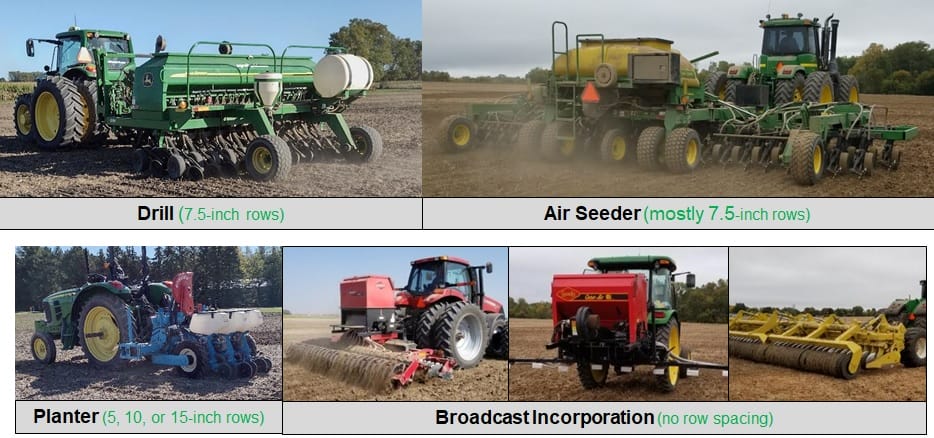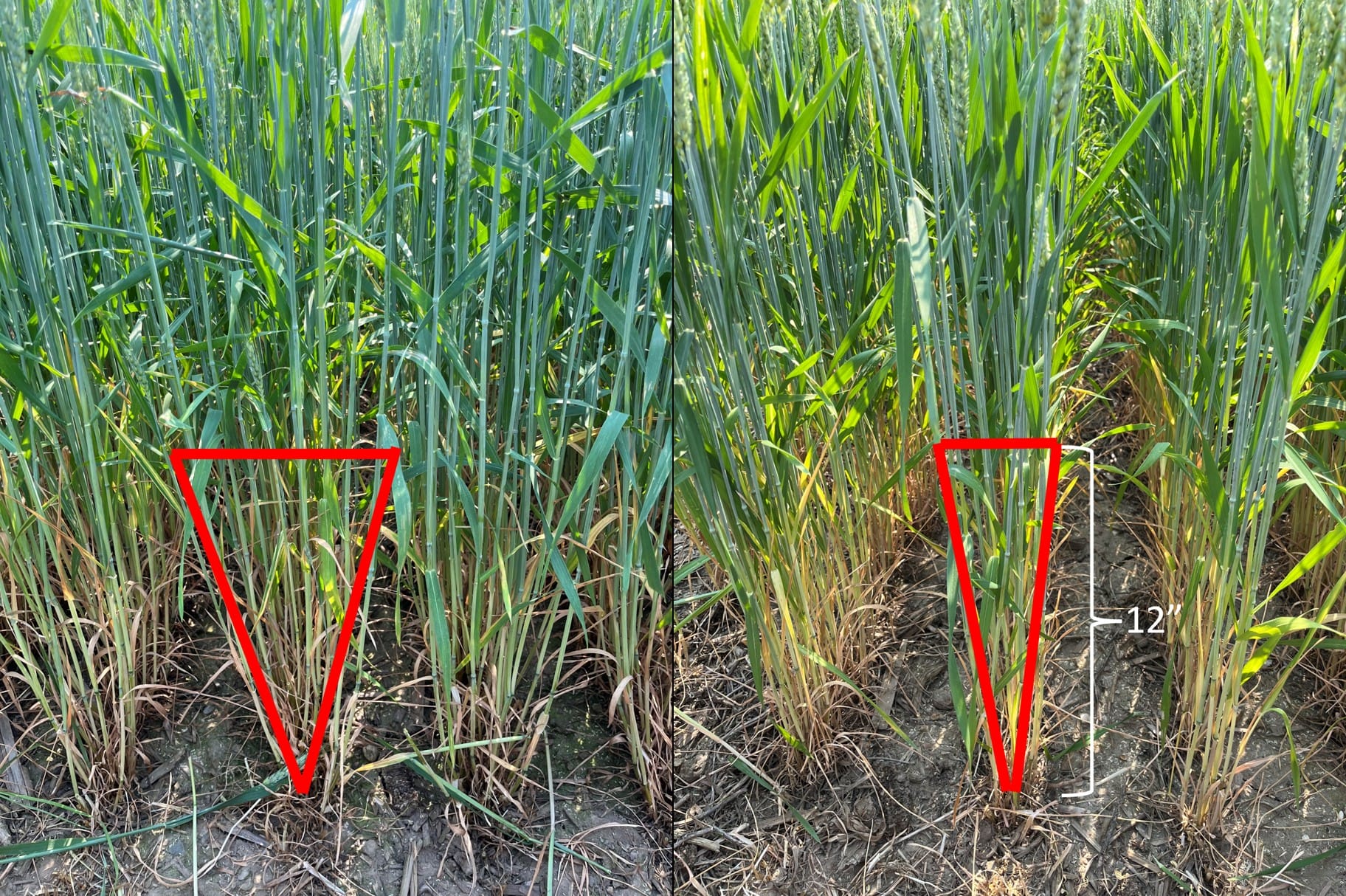Best Management Strategies for Winter Wheat
Manni Singh, a cropping systems agronomist at Michigan State University, oversees wheat research across multiple farms in Michigan. During our September 2025 shared learning call, he presented research results from 2018-2025 that assessed the optimal canopy structure for harnessing sunlight to increase grain yield. Manni focused on three main variables: planting method, planting timing and wheat canopy structure.
Trial Design and Planting Methods
The planting methods varied in row spacing, seeding depth and seed spacing. Farmers performed the trials on their own acres using three types of planters and four planting treatments. The control treatment was a conventional “spill type” drill or an air seeder planting in 7.5-inch rows.
| Row Spacing | Seeding Depth achieved | Seed Spacing | Population/ Seeding Rate | |
| Conventional Drill (Control) | 7.5-inch | ½ inch to 2 inches deep | 0.7 inch (variable) | 1.2-1.4 million seeds/acre |
| Air Seeder | 7.5-inch (mostly) | 1 inch to 2 inches deep | 0.5 inch (variable) | 1.2-1.4 million seeds/acre |
| Precision Planter (1) | 5-inch | 1 inch deep | 1.1 inches | 1.2 million seeds/acre |
| Precision Planter (2) | 10-inch | 1 inch deep | 0.5 inch
|
1.2 million seeds/acre
|
| Precision Planter (3) | 15-inch | 1 inch deep | 0.4 inch | 1.2 million seeds/acre
|
| Broadcast with Incorporation (1) | None | Surface to 3 inches deep | None | 1.2-1.4 million seeds/acre (standard) |
| Broadcast with Incorporation (2) | None | Surface to 3-inches deep | None | 1.6-1.8 million seeds/acre (30% increase) |
One treatment used a custom-built Monosem precision planter. In a precision planter, seeds are picked up one at a time and metered out via a seed disc sized for the crop being planted. Another treatment and incorporated it using a shallow tillage implement. A third treatment broadcast the seed with incorporation at a 30% higher seeding rate.
Each site performed a minimum of three treatments per year over three years; the control (drill) and broadcast with incorporation at both seeding rates (see table).
Yield Results
Yields were similar between broadcast and drill treatments planted at the standard seeding rate and increased rate. The increased broadcast seeding rate improved the yield by 2%, which did not make up for the increased seed costs.
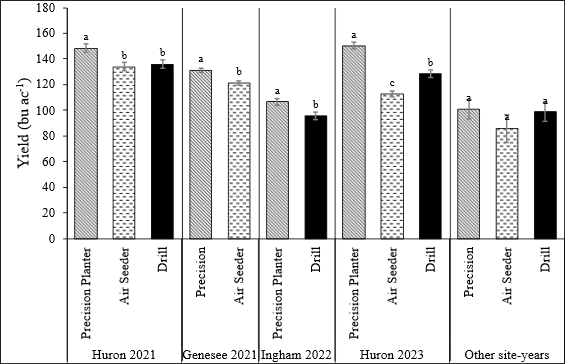
Winter wheat yield results from a planting methods study conducted by the Cropping Systems Agronomy lab at eight on-farm sites comparing the performance of precision planter in narrow rows (5 inches) with conventional drill or air seeders (mostly 7.5-inch row spacing). Other site-years are data pooled from four locations where no significant differences were found. Learn more about optimizing row spacing and seed placement for high yield potential in winter wheat.
Manni says, “Whatever we can do to plant small grains in narrow rows is beneficial; achieving more uniform seed placement is the cherry on the cake.”
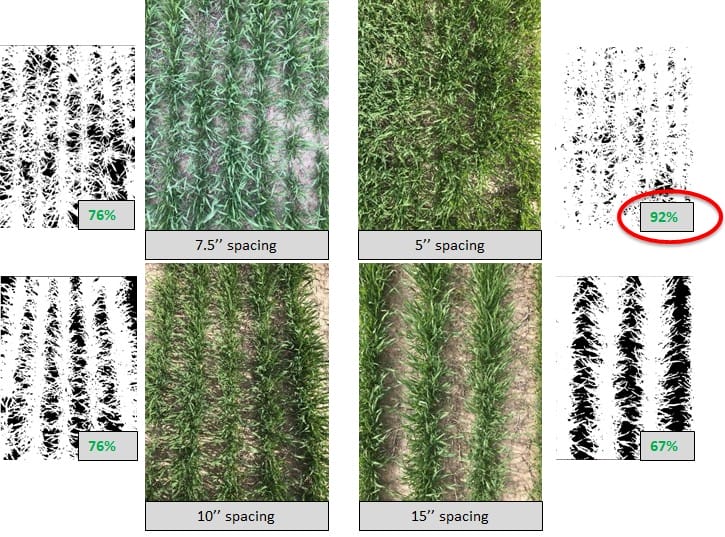
Amount of light intercepted at each row spacing (May 8, 2020). The 5-inch spacing achieved a light interception rate of 92% which directly correlates with increased yield.
Planting Timing and Impact on Yield
Manni recommends using the ‘fly-free’ date for the Hessian fly to inform planting times. The Hessian fly is no longer a common pest for small grains in our region but the ‘fly-free’ dates – the dates the adults are no longer laying their eggs on small grains – are still applicable for guiding planting times. In Iowa, these dates range from Sept. 16 in northern Iowa to Sept. 28 in the southern tier of Iowa counties.
September wheat plantings yielded 150-160 bushels per acre. Wheat planted after the early October date resulted in a 20% loss in yield. Through his research, Manni concluded in Michigan the optimal seeding rate in September is 1 million seeds per acre. It is recommended to increase the seeding rate to 1.2-1.4 million seeds per acre in early to mid-October and increase to 1.6 million seeds per acre in late October. Planting early does not always equate to increased yields, but you will save on the cost of seed.
If planting late, yields cannot recover by planting a higher seeding rate; the key is a longer fall growing season. The plants should have enough time to produce three to four tillers by winter. Manni suggests planting a test strip with a reduced seeding rate of 20% to 30% if you are planting at the optimal time. This allows you to gauge if a reduced seeding rate will work for your field conditions.
Canopy Structure
Winter wheat varieties have two main canopy types, planophile and erectophile. Planophile varieties have droopy, spread-out canopies. Erectophile varieties have upright canopies. The canopy structure affects how much light is intercepted, light use efficiency and grain yield.
Both varieties produced similar yields when planted at the optimal time, based on the ‘fly-free’ dates. For later planting dates, the planophile varieties yielded higher by covering the ground between rows faster, which increased light interception.
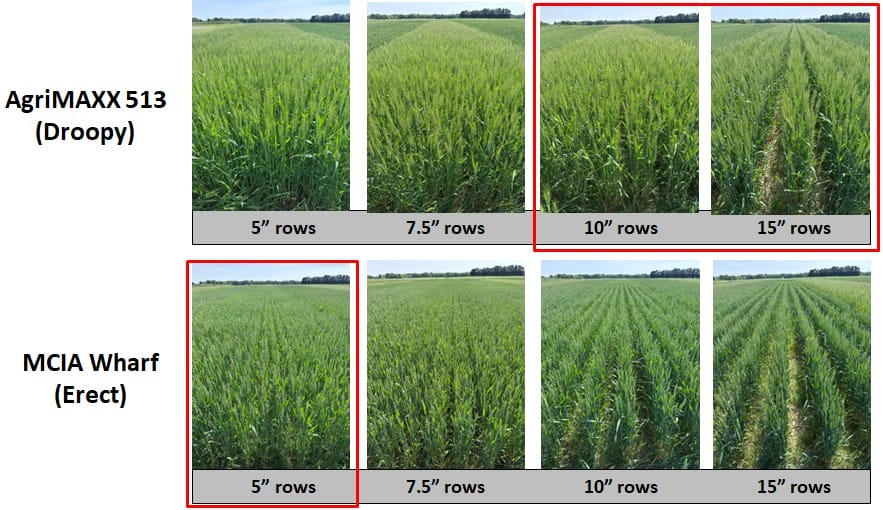
Canopy coverage at different row spacing for planophile (top) and erectophile (bottom) varieties The AgriMAXX 513 covers the gaps between the wider 10-inch and 15-inch rows quicker than MCIA Wharf, which is best suited for narrower 5-inch rows.
Manni recommends matching the canopy type to your system. Erectophile varieties are best for narrow rows planted at the earliest recommended dates while using high management practices like additional nitrogen and fungicide applications. Planophile varieties are best suited for 10-inch to 15-inch rows planted at the later dates and while using fewer inputs.
Manni says his research team has been debating about doing similar research in spring planted small grains. He speculates that spring crops would also benefit from being planted in narrow rows because their canopies would cover the space between rows before it got too hot. This minimizes the amount of sunlight hitting the ground, which minimizes evaporation loss, leading to more robust plants with higher yields.
Planting in narrow rows is a newer concept in the United States and machinery hasn’t caught up. Manni recommends reworking your current system to plant in narrow rows. If that doesn’t work, find a used piece of equipment you can modify to do just that.
Additional Resources:
Explore more of Manni’s research:

